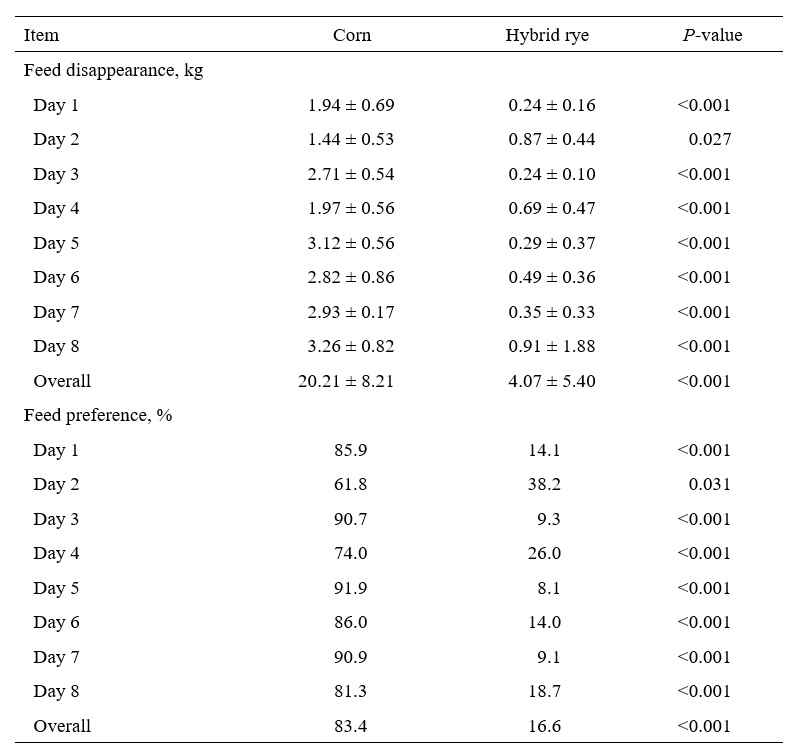In many parts of the world, including the United States, corn is the primary energy source used in diets for pigs, but there are no published data comparing the growth performance of growing pigs fed diets in which hybrid rye replaces corn. Unfamiliarity with hybrid rye also makes some producers in the United States reluctant to try feeding hybrid rye to pigs, as there is a long-standing belief that rye is less palatable than other feed ingredients. Therefore, two experiments were conducted to test the hypotheses that there is no difference in feed preference for diets containing either hybrid rye or corn as the exclusive cereal grain source, and that hybrid rye may replace a portion of corn in diets for growing pigs without adversely affecting growth.
Experimental Procedures
Exp. 1
Eighteen gilts and 18 barrows with an initial body weight of approximately 32 kg were used in the experiment. One barrow and one gilt were housed in each pen; thus, there were 18 replicate pens in the experiment. One diet based on corn and soybean meal and one diet based on hybrid rye and soybean meal were formulated (Table 1). All pigs were allowed ad libitum access to the corn-soybean meal diet in one feeder and the hybrid rye-soybean meal diet in the second feeder. The positions of the 2 feeders were switched daily to minimize the effect of feeder location preference. Feed allotment and disappearance were recorded daily during the 8 d experiment.
Exp. 2
A total of 128 growing pigs (initial body weight approximately 27 kg) were allotted to a completely randomized design with 4 treatments. Thirty two pens were used with 4 pigs per pen and 8 replicate pens per treatment. Pigs were fed experimental diets for 27 d. A basal diet primarily based on corn and soybean meal was formulated (Table 1). Three additional diets were formulated by replacing 33, 66, or 100% of the corn in the basal diet with hybrid rye. Individual pig weights were obtained at the beginning of the experiment and at the conclusion of the experiment, and feed allowance was recorded daily.
Results
In Exp. 1, pigs consumed more (P < 0.05) of the corn-based diet than of the rye-based diet from d 1 through d 8, and for the overall period (Table 2). Subsequently, the calculated preference (%) for the hybrid-rye based diet was less (P < 0.05) than for the corn-based diet for each day and for the overall period. Even though pigs demonstrated strong preference for corn over hybrid rye in Exp. 1, it was hypothesized in Exp. 2 that feed intake among treatments would not be affected when pigs were offered a single diet. However, the hypothesis was not supported, as there was a tendency (linear, P < 0.10) for average daily feed intake (ADFI) to be reduced as hybrid rye inclusion in the diet increased (Table 3). The reduction in ADFI at high inclusion rates of hybrid rye may be a reflection of the preference for corn observed in Exp. 1. In Exp. 2, however, no differences were observed among treatments for initial nor final body weight. Average daily gain was not affected by dietary treatment, and the same was true for gain:feed (G:F).
Key Points
- Growing pigs preferred corn to hybrid rye when given the choice between two diets.
- In the second experiment, feed intake was linearly reduced when pigs were fed diets containing large portions of hybrid rye, but ADG and G:F were not affected by diet, even when up to 67% hybrid rye was included in the diet.
- The reluctance of pigs to consume hybrid rye in the first experiment could be due to simple taste preference, but the satiating effects of hybrid rye’s dietary fiber in the gastrointestinal tract may also have contributed to the reduced feed intake observed in the second experiment.
- More research is needed to determine the effects on the growth performance and carcass quality of growing-finishing pigs when hybrid rye replaces corn at high inclusion rates and for longer duration.
- Under the conditions of this experiment it appears that hybrid rye can replace corn in diets for growing pigs without any changes in pig growth performance.
Table 1. Ingredient composition of experimental diets for growing pigs

1Other ingredients included limestone, dicalcium phosphate, crystalline amino acids, salt, and vitamin-mineral premix.
Table 2. Daily and overall feed disappearance and feed preference in Exp. 1

Table 3. Growth performance of pigs fed diets in which portions of corn in corn-soybean meal control diets were replaced with hybrid rye in Exp. 2
